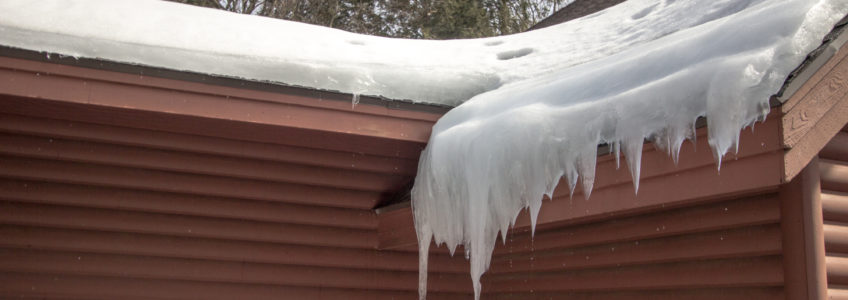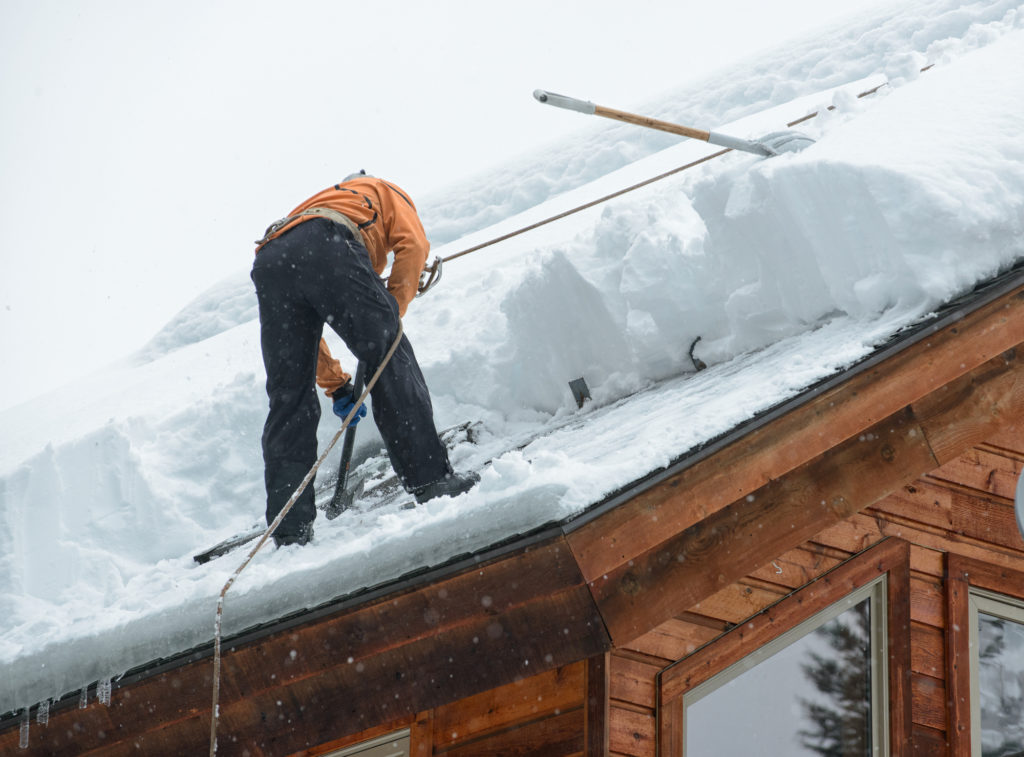
Ice dams are common in snowy parts of the United States and can be quite a nuisance in the months with heavy snowfall. There are many ways they can be prevented or even avoided completely should property owners take proper precautions. If you’re located in a snowy part of the county, it’s recommended to familiarize yourself with ice dams as they can be extremely destructive to your property if appropriate measures and maintenance aren’t taken.
What is an Ice Dam?
An ice dam forms along the edge of your roofline when melting snow freezes. This occurrence prevents excess water from draining properly off your roof. Ice dams can also form around vents, skylights, and anywhere two inclined sides of the roof meet. While frozen, ice dams don’t pose a significant threat, but in the warmer parts of winter, there is potential that water from the melting ice will pool up and seep under the shingles. If pooled for an extended amount of time, the water will begin to flow through the roof into other parts of your house, resulting in extreme damage to your property.
What Causes an Ice Dam?
The temperature of your roof has an enormous influence on the formation of ice dams as nonuniform roof surface temperatures are proven to lead to ice dams. Snow must be present on the roof, and higher portions of the roof must be above freezing while lower surfaces are below freezing. The snow that is above freezing will melt, and as this water flows down, it will reach the portion of the roof that is below freezing, thus making the water freeze resulting in an ice dam. This cycle repeats itself, continuing to freeze, and adding size to the ice dam each time.
It’s vital to identify the occurrence of ice dams in their early stages as the pooled water will eventually begin working through shingles or other roofing material, flow through the roof decking, and enter the attic. If this occurs, the water can continue to seep through the ceiling, interior walls, and into the rest of the building, causing extensive damage and the potential for mold growth. The weight of the ice dam can also damage your gutters.
Effects Ice Dams Have on Your Property
As previously mentioned, if ice dams form for long periods before being identified, it can be very detrimental to your property. If high volumes of moisture enter your home from ice dams, the potential for mold and mildew to grow increases substantially, which can cause respiratory problems for household residents. It’s recommended to immediately dry out any areas that are wet or damp and take action to resolve the underlying issue as soon as possible.
Ice Dam Removal Solutions
Professionals and property owners have established an assortment of solutions for ice dam removal over the years, but if you’re limited on time or need an immediate solution before consulting a professional, there are a few methods that are very popular and effective.
Eliminate Its Source
Ice dams will continue to grow throughout the season if left alone. Removing current accumulations of snow and ice present on your roof with a snow rake is an excellent way to be proactive and eliminate the source that is causing the ice dam to form. Shingles are fragile, so be sure to use caution when utilizing the rake to avoid dislodging any parts of your roof.
Use a Deicer Product
If you don’t have time to rake your roof or chip away the dams, a chemical deicing product is the next best option. These products contain an assortment of chemicals that speed up the melting process and can be found at hardware and home improvement stores. Usually coming in the form of tablets or crystals, you will be able to distribute the substance along the ice in your gutter efficiently. Over time, the chemicals will work to melt the ice allowing the buildup to diminish and drain through your gutters.
Reuse Old Stockings or Panty Hose
While this seems like a strange solution, it’s a great way to take care of ice dams if you have a busy schedule. Fill old stockings or pantyhose with a chemical deicing solution and adequately close the ends so none of the materials can escape. Place these garments on top of the dams and let them work their magic. Over time, the contents will leak through the fabric and melt the ice. The process can take a little longer than others, and the position of the garments will have to be monitored as you may have to adjust placement as the ice continues to break down.
Spray Warm Water
Utilizing this method only provides a quick solution with instantaneous results until you have more time to assess the situation. Put hot water in a spraying device and spray water along the ice dams to loosen it up and kickstart the melting process. Keep in mind that the hot water will eventually turn cold and freeze as well, so adapting another solution to accompany a warm water spray will likely give you better results.
Ice Dam Prevention
There are several yearly things property owners can do to prevent ice dams from forming, but a few are crucial. It’s encouraged to clean your gutters out regularly to ensure proper drainage and utilize a roof rake in the winter months, so the buildup of ice and snow is kept to a minimum. Along with these simple solutions, many others are more time consuming or may require professional assistance.
- Close Attic Bypasses
- Measure Attic Insulation Levels
- Add Roof and Soffit Vents
- Utilize an Adhesive Ice-and-Water Barrier
- Heat Cable Installation
Final Words
While property owners commonly experience a multitude of maintenance issues throughout a lifetime, ice dams can be a pest in the colder months if you don’t take proper precautionary measures to prevent them from occurring. Ice dams form when an excessive amount of snow and ice accumulates on your roof, and the melted water has limited or nonexistent drainage access. Becoming familiar with removal methods and preventative steps are vital to a comfortable, low-maintenance winter for your household.

